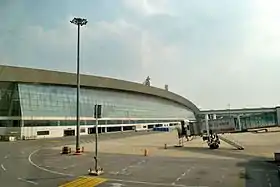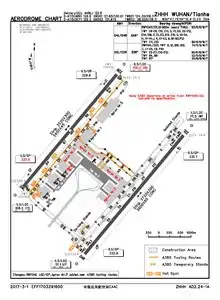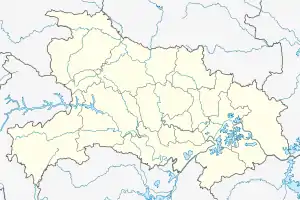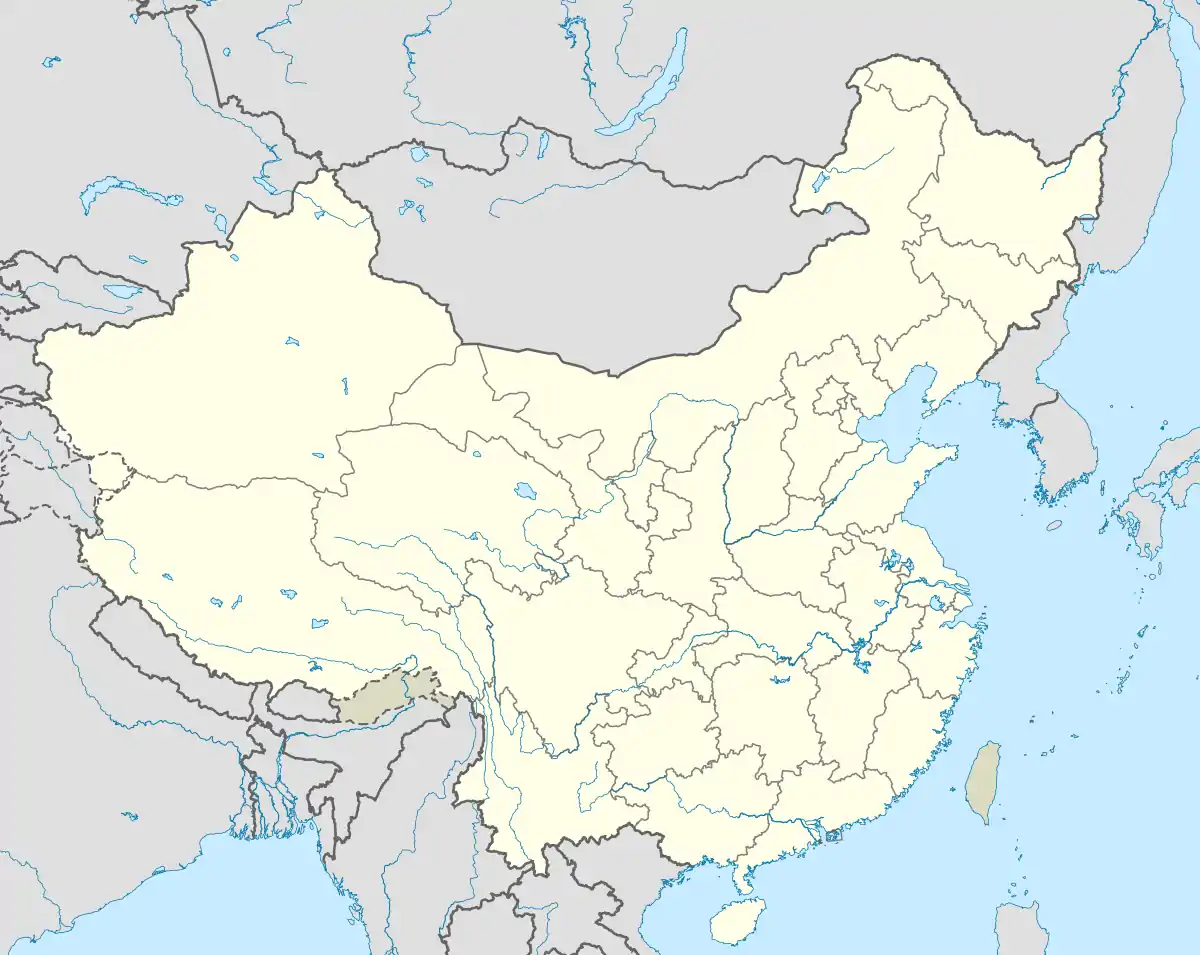Wuhan Tianhe International Airport
Wuhan Tianhe International Airport (IATA: WUH, ICAO: ZHHH) serves Wuhan, the capital of the Hubei province, People's Republic of China. It was opened on 15 April 1995, replacing the old Hankou Wangjiadun Airport and Nanhu Airport as the major airport of Wuhan.[1][2] The airport is located in Wuhan's suburban Huangpi District, around 26 km (16 mi) to the north of Wuhan city center.
Wuhan Tianhe International Airport 武汉天河国际机场 | |||||||||||||||
|---|---|---|---|---|---|---|---|---|---|---|---|---|---|---|---|
 | |||||||||||||||
| Summary | |||||||||||||||
| Airport type | Public | ||||||||||||||
| Operator | Wuhan Tianhe International Airport Co. Ltd. | ||||||||||||||
| Serves | Wuhan | ||||||||||||||
| Location | Huangpi District, Wuhan | ||||||||||||||
| Focus city for | |||||||||||||||
| Elevation AMSL | 34 m / 112 ft | ||||||||||||||
| Coordinates | 30°47′01″N 114°12′29″E | ||||||||||||||
| Website | www | ||||||||||||||
| Maps | |||||||||||||||
 CAAC airport chart | |||||||||||||||
 WUH  WUH | |||||||||||||||
| Runways | |||||||||||||||
| |||||||||||||||
| Statistics (2018) | |||||||||||||||
| |||||||||||||||
| Wuhan Tianhe International Airport | |||||||
|---|---|---|---|---|---|---|---|
| Simplified Chinese | 武汉天河国际机场 | ||||||
| Traditional Chinese | 武漢天河國際機場 | ||||||
| |||||||
It is the busiest airport in central China as it is geographically located in the centre of China's airline route network. The airport served 20,772,000 passengers in 2016, making it the 14th busiest airport by passenger traffic in China. The airport is a focus city for Air China, China Eastern Airlines, and China Southern Airlines. The airport has flights to international destinations such as New York City, San Francisco, Tokyo, Rome, Istanbul, Dubai, Sydney, Bali, Bangkok, Moscow, Osaka, Seoul, and Singapore. The name Tianhe (天河) can be literally translated as "Sky River"; Tianhe is also one of the names for the Milky Way in ancient Chinese.[3]
Since 2019, passengers from 53 countries such as the EU countries, Japan, South Korea, Russia, the U.S., when transiting to a third country, can enter China from this airport without a Chinese visa for up to 144 hours.[4][5]
On 23 January 2020, the airport was closed due to the 2020 Hubei lockdowns in response to the COVID-19 pandemic, which originated in Wuhan.[6] The airport reopened on 8 April 2020 following a large-scale disinfection.[7]
History
To replace the old Wangjiadun Airport, the Chinese government permitted plans to build a commercial airport in Tianhe Town, Huangpi District, Wuhan on 1 July 1985. The first term construction started in December 1989 and finished in April 1994. It initially operated domestic flights but later in 2000, the CAA re-designated it as an international airport.
The airport has expanded twice – first for terminal 2 and second for terminal 3, new control tower and the second runway.
Wuhan opened up to intercontinental flights when Air France began service from Paris on 11 April 2012,[8] and two years later opened up to the United States non-stop when China Southern Airlines announced, in September 2014, a daily non-stop flight to San Francisco, originating from Guangzhou, operating with a Boeing 787 to begin 16 December 2014.[9]
Facilities
Runways
Tianhe International Airport has two runways.
Runway West (04L 22R)
Length: 3,400 m (11,200 ft), width: 45 m (148 ft)
Runway East (04R 22L main runway)
Length: 3,600 m (11,800 ft), width: 60 m (200 ft)
ILS
Tianhe Airport equipped with ILS II in south side (main landing side), ILS I in north side. The East runway is equipped with blind landing systems.
Terminal 1 (demolished)
Terminal 1 was opened in 1995 when all flight services were transferred from Nanhu Airport to Tianhe International Airport. It was located at where the west concourse of Terminal 3 stands nowadays. It had been the only terminal of the airport until Terminal 2 was completed in 2008.
From 2008 onwards, all domestic flights were operated at T2 while international flights were still operated at T1. T1 was closed in 2010 after serving international flights for two years. A new international terminal was built in 2010, and has undergone subsequent expansions after seeing major increase of international travelers. The terminal was demolished during the construction of Terminal 3.[10][11]
Terminal 2 (closed)
Terminal 2 was the main terminal for Tianhe Airport during 2008–2017, which handled only domestic airlines. It has a floor area of 121,200 square meters and a designed capacity to handle 13 million passengers and 320,000 tons of cargo a year. The project was completed on 15 April 2008, at a total cost of 3.37 billion yuan (421.5 million US dollars). By 2010, Wuhan served at least 5 international and 100 domestic routes. The airport's cargo-handling capacity is to reach 144,000 tons.
Terminal 2 was closed when Terminal 3 were officially opened in mid 2017 for the upgrade construction. [12]
International Terminal (closed)
.jpg.webp)
The International Terminal was opened in December 2010 and all international flights and flights to Hong Kong, Macau and Taiwan operated at the International Terminal from 2010 to 2017. After the old Terminal 1 was closed in 2010, the International Terminal was sometimes mistakenly called "T1" by passengers.
The single-floor terminal is located at the southwest of Terminal 2. It has a floor area of 5310 square meters, shared by both departure and arrival facilities. To handle wide-body jet within limited ramp, there is no air-bridge for this terminal.[13]
Due to its compact size and the growing number of international flights, there were complaints that Terminal 1 was "too crowded". In 2013, the average departure traffic was 880 per hour during the peak season, which was far greater than its designed maximum capacity of 550.[14]
The International Terminal was closed in mid 2017 and it will be turned to a chartered and VIP terminal in the future.
Terminal 3
Starting from 31 August 2017, all flights from the original International Terminal (international, Hong Kong, Macau and Taiwan) and T2 (domestic) have been moved to Terminal 3, which has a passenger capacity of 35 million. Following the opening of the new Terminal 3, International Terminal (IT) and Terminal 2 (T2) were closed temporarily for renovation. IT is scheduled to operate as the VIP terminal. T2 will undergo renovation and reopen when passengers in T3 exceed the design limit.[15]
The T3 has a new departure lounge, restaurants and duty-free shops.
The construction of Terminal 3 started in June 2013 and it was opened on 31 August 2017. A new runway, new control tower, and a transportation hub connecting the airport to the city with an intercity railway and a metro line have been built and opened along with the new terminal.[16]
Airlines and destinations
Passenger
Gallery
 Airport departure hall
Airport departure hall A China Eastern airplane approaching Terminal 2
A China Eastern airplane approaching Terminal 2 inside the airport
inside the airport Baggage claim area
Baggage claim area Parking garage under the airport
Parking garage under the airport A Xinhua Airline plane in front of the then Terminal 2
A Xinhua Airline plane in front of the then Terminal 2 International terminal (the new Terminal 1)
International terminal (the new Terminal 1) The 1st Airport Expressway
The 1st Airport Expressway The 2nd Airport Expressway
The 2nd Airport Expressway Wuhan Tianhe Terminal 3
Wuhan Tianhe Terminal 3





Transportation
Roads
Two tolled expressways, the S18 Wuhan Airport Expressway and the S19 Wuhan Airport 2nd Expressway, connect the airport to downtown Hankou.[49]
Public Transit
There is a limited bus service between Wuhan Tianhe Airport and several bus stops in the urban area of Wuhan.[50]
The Wuhan–Xiaogan intercity railway, one of the lines of the Wuhan Metropolitan Area intercity railway, serves Wuhan Tianhe Airport. This railway opened in December 2016.[51]
The extension of Line 2 of Wuhan Metro to Tianhe International Airport station opened on 28 December 2016.[52]
Future development
Presently, Tianhe is the only civic airport in the Wuhan metropolitan area. However, the city authorities are considering repurposing the military Shanpo Airfield (山坡机场; 30°05′17″N 114°18′52″E), located in the city's far southern suburbs (Shanpo Township, Jiangxia District), as a commercial cargo airport. If the plans are implemented, Shanpo will become Wuhan's second airport.[53]
References
- "1995年4月15日武汉天河机场投入营运". 荆楚网. 17 April 2008. Retrieved 30 June 2011.
- "中國空軍漢口機場歷經10年竣工". 大公網. 8 June 2007. Retrieved 11 February 2008.
- "Explanation of Tianhe". Retrieved 15 October 2012.
- "2019年1月1日起武汉将实施外国人144小时过境免签". Hubei Daily. Retrieved 23 February 2019.
- "厦门青岛武汉成都昆明五个城市将实施外国人144小时过境免签政策". National Immigration Administration of China. Retrieved 23 February 2019.
- Fifield, Anna (22 January 2020). "City at center of coronavirus outbreak suspends travel to contain spreading illness". The Washington Post. Retrieved 22 January 2020.
- "Wuhan airport geared up for reopening on April 8". China Daily. Retrieved 6 April 2020.
- "Air France launches new route to Wuhan in China". 18 April 2012.
- "China Southern Plans San Francisco Service from mid-Dec 2014". Airline Route. 4 September 2014. Retrieved 4 September 2014.
- 天河机场 国际航站楼 下月扩建. Retrieved 3 February 2012.
- 武汉天河机场建成新国际航站楼. Archived from the original on 2 May 2013. Retrieved 5 July 2012.
- "Xinhua - English". Archived from the original on 20 October 2014. Retrieved 1 June 2015.
- 武汉天河机场国际航站楼正式启用. Retrieved 19 January 2017.
- 旅客“吐槽”天河机场国际航站楼候机太拥挤. 武汉晚报 [Wuhan Evening News]. Retrieved 19 January 2017.
- "武汉天河机场三号航站楼成功转场启用". news.ifeng.com.
- 网易. "天河机场三期全面建成 T3航站楼2017年3月启用_网易财经". money.163.com.
- "Air China Begins Wuhan – Surat Thani Route from late-April 2015". Retrieved 1 June 2015.
- 【新开航线】总有一个地方,承着你的诗和远方。
- 锦州=武汉=深圳航线将于10月28日正式通航
- "3月27日起柳州机场将开通两条到三亚的航线_民航新闻_民航资源网". news.carnoc.com.
- "China Eastern adds Wuhan – Myanmar service from late-May 2019".
- "长沙、海口、武汉...日照机场又开新航线!_民航新闻_民航资源网". news.carnoc.com.
- ""世界水都,亚洲天池"--湖北十堰,东航将于10月28日起开通乌鲁木齐-十堰-武汉航线".
- "China Eastern reopens Wuhan – Sydney reservation from late-Jan 2017". routesonline. Retrieved 5 January 2017.
- "China Eastern adds new Tokyo Narita routes in 1Q20". RoutesOnline. 10 November 2019. Retrieved 10 November 2019.
- "China Eastern adds Wuhan – Myanmar service from late-May 2019".
- 2018, UBM (UK) Ltd. "China Southern adds Wuhan – Ho Chi Minh City from late-July 2018".CS1 maint: numeric names: authors list (link)
- https://www.eturbonews.com/1977730/china-southern-airlines-launches-direct-wuhan-islamabad-flights/
- "China Southern adds Wuhan – Istanbul service from May 2019". routesonline. Retrieved 2 April 2019.
- Liu, Jim. "China Southern schedules new Macau routes from late-Oct 2019". Routesonline. Retrieved 4 October 2019.
- https://www.routesonline.com/news/38/airlineroute/286631/china-southern-w19-japan-service-changes-as-of-27sep19/
- "China Southern schedules Wuhan – New York launch from July 2019". routesonline. Retrieved 14 May 2019.
- "JC International adds Sihanoukville – Wuhan service from late-May 2019".
- "Juneyao Airlines adds new routes to Japan in W19". routesonline. Retrieved 9 September 2019.
- Liu, Jim. "Lanmei Airlines further expands China network June - August 2019". Routesonline. Retrieved 17 July 2019.
- "Malindo Air Plans Wuhan Service from late-June 2016". routesonline. Retrieved 3 June 2016.
- 2018, UBM (UK) Ltd. "Jetstar Pacific Adds New Cam Ranh/Nha Trang – China Charters in W15".CS1 maint: numeric names: authors list (link)
- https://cnnphilippines.com/news/2020/1/26/Wuhan-China-tourists-Philippines.html
- https://mp.weixin.qq.com/s/KQIFlF2AKUAM8aWe0vqluA
- "Scoot assumes Silk Air Wuhan service from late-May 2019". Airlineroute. 1 May 2019. Retrieved 1 May 2019.
- "Frequent fliers on some SilkAir routes will soon have to fly Scoot, SIA announces ahead of merger". businessinsider.sg. Retrieved 30 October 2019.
- "Spring Airlines to Start Wuhan – Osaka Service from mid-July 2014". Retrieved 1 June 2015.
- New Destination : Bangkok - Wuhan
- Liu, Jim. "T'Way Air adds Seoul – Wuhan service from late-Jan 2020". Routesonline. Retrieved 16 January 2020.
- Liu, Jim. "Urumqi Air adds Nagoya service from late-Dec 2019". Routesonline. Retrieved 26 November 2019.
- "Urumqi Air adds Singapore service from mid-May 2019".
- https://www.shine.cn/biz/company/2011059146/
- https://www.aircargonews.net/airlines/sf-airlines-launches-frankfurt-freighter-link/
- 武汉机场二通道继续免费 15分钟从香港路开到机场 (Second Airport Expressway is now open and remains free for the time being)
- 天河机场大巴运行时刻表 (Tianhe Airport bus schedule)
- 方圆震. "武汉城市圈第4条城际铁路正式开通 空铁交通实现无缝对接_滚动新闻_中国政府网". gov.cn.
- "武汉地铁机场线开通 乘地铁赶飞机还需留意这两点_荆楚网". news.cnhubei.com.
- 武汉第二机场项目已上报发改委 江夏山坡机场开始“控违” (The plan for Wuhan's second airport has been submitted to the National Development and Reform Commission. Shanpo Airfield, in Jiangxia District, started to be considered), 21 November 2012
External links
| Wikimedia Commons has media related to Wuhan Tianhe International Airport. |
- Wuhan Tianhe International Airport Official website (in Chinese)
- Airport information for ZHHH at World Aero Data. Data current as of October 2006.
.jpg.webp)